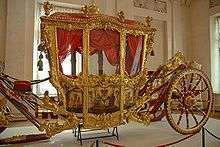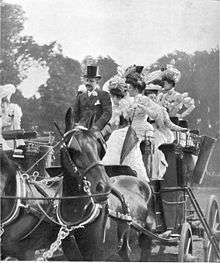Coach (carriage)
A coach is originally a large, usually closed, four-wheeled carriage with two or more horses harnessed as a team, controlled by a coachman and/or one or more postilions. It had doors in the sides, with generally a front and a back seat inside and, for the driver, a small, usually elevated seat in front called a box, box seat or coach box. The term "coach" first came into use in the 15th century, and spread across Europe. There are a number of types of coaches, with differentiations based on use, location and size. Special breeds of horses, such as the now-extinct Yorkshire Coach Horse, were developed to pull the vehicles.

History
_-_Mar_2010.jpg)
.jpg)
Kocs was the Hungarian post town in the 15th century onwards, which gave its name to a fast light vehicle, which later spread across Europe. Therefore, the English word coach, the Spanish and Portuguese coche, the German Kutsche, and the Slovak koč and Czech kočár all probably derive from the Hungarian word "kocsi", literally meaning "of Kocs".[1][2]
It was not until 1580, in the reign of Queen Elizabeth I, that coaches were introduced to England. These were designed to be pulled by a pair of horses. In 1619 George Villiers, 1st Duke of Buckingham introduced the coach and six horses.[3]
Coaches were reputedly introduced into England from France by Henry FitzAlan, 19th Earl of Arundel.[4]
A coach with four horses is a coach-and-four.[5] A coach together with the horses, harness and attendants is a turnout.[6]
The bodies of early coaches were hung on leather straps. In the eighteenth century steel springs were also used in suspension systems. An advertisement in the Edinburgh Courant for 1754 reads:
The Edinburgh stage-coach, for the better accommodation of passengers, will be altered to a new genteel two-end glass coach-machine, hung on steel springs, exceedingly light and easy...
Strap suspensions persisted, however; the 19th century American Concord coaches used leather straps exactly as the first Berline from 1660 did.
A coach might have a built-in compartment called a boot, used originally as a seat for the coachman and later for storage. A luggage case for the top of a coach was called an imperial; the top, roof or second-story compartment of a coach was also known as an imperial.[7] The front and rear axles were connected by a main shaft called the perch or reach. A crossbar known as a splinter bar supported the springs. Coaches were often decorated by painters using a sable brush called a liner.
In the 19th century the name coach was used for U.S. railway carriages,[8] and in the 20th century to motor coaches.
See John Taylor (poet) for a very adverse opinion of the arrival of horsedrawn coaches in England.
Types
.jpg)
_1880.jpg)
_(cropped).jpg)
Marathon competition Stoneleigh Park
There are a number of coach types, including but not limited to:
- Coach: a large heavy vehicle designed to carry passengers
- State coach: A coach of state is used to carry very important persons, like a visiting head of state, royalty and (antique) high nobility such as princes and dukes on state occasions.
- Private coach: a very expensive cumbersome 17th century luxury replaced as they were developed by light fast carriages except on formal occasions.
- Road coach: a private coach kept for pleasure. See Driving club
- Drag or (U.S.) Park drag: a gentleman's coach kept for pleasure. See Driving club
The principal ceremonial coaches in the United Kingdom are the Gold State Coach, Irish State Coach and Scottish State Coach.
Coaches for public hire or transport
- funeral coach: not a coach but a U.S. name for a hearse, a wagon adapted to carry a coffin
- hackney coach a hired coach
- Stagecoach: heavy, usually four-in-hand, closed; built to carry passengers on scheduled long-distance services changing exhausted horses at stage stations, carrying as many as twenty passengers and goods
- Mail coach or post coach: same as a stagecoach, used for carrying mail but it carries premium-fare passengers and keeps to a very fast and precise schedule
- Concord coach: as stagecoach — designed with its body swung on leather thorough-braces was to help cope with bad roads.
- Stage wagon or mud wagon: (U.S.) lighter and smaller than a stagecoach, flat sides, simpler joinery
Miscellany
_-_Mar_2010.jpg)

The business of a coachman, like the pilot of an aircraft, was to expertly direct and take all responsibility for a coach or carriage and its horses, their stabling, feeding and maintenance and the associated staff. He was also called a jarvey or jarvie, especially in Ireland; Jarvey was a nickname for Jarvis.
If he drove dangerously fast or recklessly he was a jehu (from Jehu, king of Israel, who was noted for his furious attacks in a chariot (2 Kings 9:20), or a Phaeton (from Greek Phaethon, son of Helios, who attempted to drive the chariot of the sun but managed to set the earth on fire).
A postilion or postillion sometimes rode as a guide on the near horse of a pair or of one of the pairs attached to a coach, especially when there was no coachman. A guard on a horse-drawn coach was called a shooter.
Traveling by coach, or pleasure driving in a coach, as in a tally-ho, was called coaching. In driving a coach, the coachman used a coachwhip, usually provided with a long lash. Experienced coachmen never used the lash on their horses. They used the whip to flick the ear of the leader to give them the office to move on, or cracked it next to their heads to request increased speed.
- box coat: a heavy overcoat with or without shoulder capes used by coachmen (riding on the box seat) exposed to all kinds of weather.[9]
- hammercloth: ornamented and often fringed was hung over the coachman's seat, especially on a ceremonial coach.[10]
- cockhorse: An extra horse led behind a coach to be hitched when passing over steep or difficult terrain.
- stable was a building to shelter horses usually close to the owner's house. Staff accommodation would be close often within the same building.
- coach house was a special building for sheltering a coach or coaches but coaches were more often kept within the stable building.
- coaching inn or coaching house provided accommodation for travellers and usually provided a change of horses and offered stabling.
- coach dog or carriage dog was trained to run in attendance on a coach particularly Dalmatians.
Coach horses
A coach horse or coacher bred for drawing a coach is typically heavier and of more compact build than a road horse and exhibits good style and action.[11] Breeds include:
- Breton: heavy, French, for draft or meat
- German coach: large, rather coarse, heavy draft horse or harness horse; bay, brown or black in color
- Hanoverian: developed by crossing heavy cold-blooded German horses with Thoroughbreds
- Holstein: German, heavyweight, for riding and dressage, initially a carriage horse; bay, black or brown. Called also Holsteiner, Warmblut, Warmblood.
- Yorkshire Coach Horse: large, strong, bay or brown; dark legs, mane and tail; belongs to an English breed derived largely from the Cleveland Bay
References
- "coach". CollinsDictionary.com. HarperCollins. Retrieved November 12, 2012.
- Definition "coach" in Merriam-Webster Dictionary.
- The Book of Days by robert Chambers
- Percy, S.; Percy, R. (1823). The Percy Anecdotes. T. Boys. p. 54. Retrieved 2014-10-12.
- Definition of coach-and-four by the Free Online Dictionary, Thesaurus and Encyclopedia. Free access.
- Turn out – Definition from the Merriam-Webster Online Dictionary.
- Definition of imperial by the Free Online Dictionary, Thesaurus and Encyclopedia. Free access.
- Oxford English Dictionary
- Box Coat. Probert Encyclopaedia.
- Hammercloth in Merriam-Webster Unabridged Dictionary (2000).
- Detailed information about specific breeds of horses: Carriage Horses in Britain. Georgian Index.
External links
| Wikimedia Commons has media related to Coaches (carriage). |
| Wikiquote has quotations related to: Coaches |
| Wikisource has the text of the 1911 Encyclopædia Britannica article Coach. |
- Belgian coach museum in Bree
- Coaches 1750 to 1900. History Learning Site.
- The Coaches: 'Travellers in Eighteenth-Century England'. Civilization defined and explained in plain English: Library of mainly eighteenth century authors by P.Atkinson.
- Coaching History. By Anne Woodley. Also Coaching Accidents, Coaching Anecdotes and A selection of Georgian Coaches
- Coachman Driven Vehicles. Carriage Museum Of America.
- H3875 Horse-drawn coach, mail and passenger coach, timber / metal / leather, made by Cobb and Co. Coach and Buggy Factory, Charleville, Queensland, Australia, 1890 – Powerhouse Museum Collection. Powerhouse Museum | Science + Design | Sydney Australia.
- The History of Coaching—Travelling in Old England—The First Coaches Introduced of The Mail-Coach System—Amateur Coachmen in the Olden Time—Early Coaching Parades—The Dangers of the Road—Highwaymen and Reckless Drivers. The New York Times, May 5, 1878, page 10.
- Col. Delancey Kane and "The Pelham Coach". Historic Pelham.
- Landscape Property|Regency|Georgian|history|lifestyle|house | Going By Coach. Jane Austen Centre Bath UK England.
- Some Coaching Costumes by Marie Weldon, The New York Times, Magazine Supplement, page SM4.